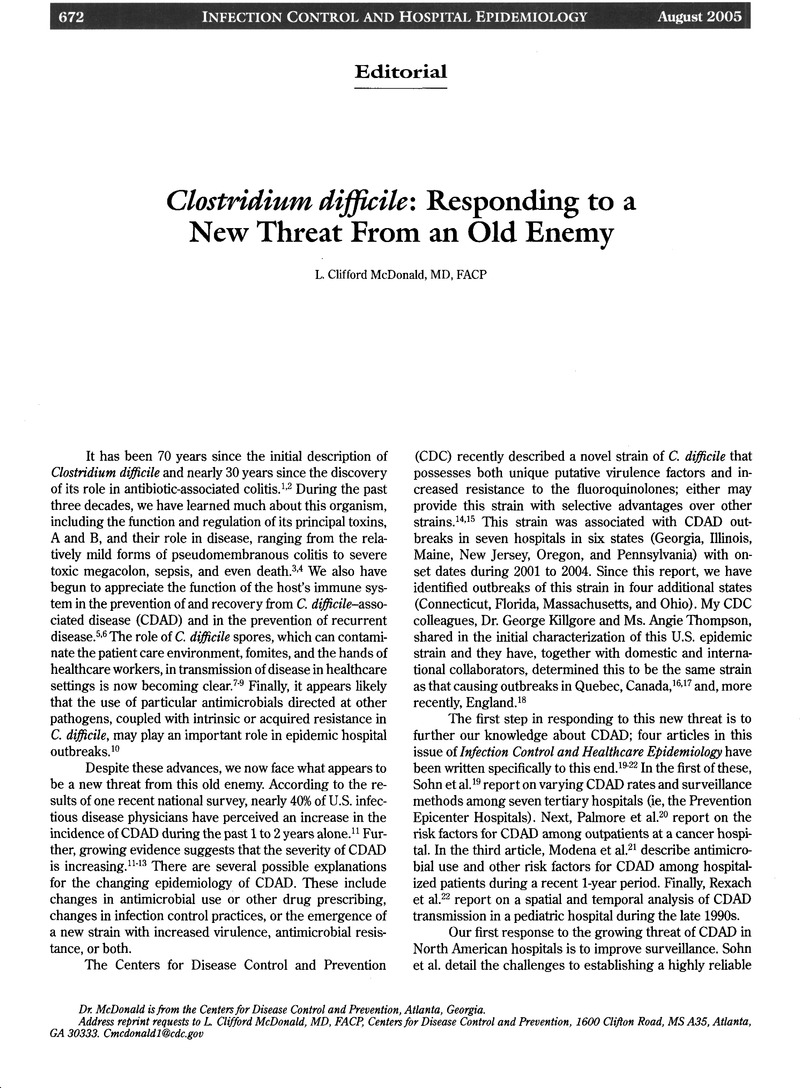Crossref Citations
This article has been cited by the following publications. This list is generated based on data provided by Crossref.
Bartlett, John G.
2006.
Narrative Review: The New Epidemic of Clostridium difficile–Associated Enteric Disease.
Annals of Internal Medicine,
Vol. 145,
Issue. 10,
p.
758.
McDonald, L. Clifford
Owings, Maria
and
Jernigan, Daniel B.
2006.
Clostridium difficileInfection in Patients Discharged from US Short-stay Hospitals, 1996–20031.
Emerging Infectious Diseases,
Vol. 12,
Issue. 3,
p.
409.
Aslam, Saima
and
Musher, Daniel M.
2006.
An Update on Diagnosis, Treatment, and Prevention of Clostridium difficile–Associated Disease.
Gastroenterology Clinics of North America,
Vol. 35,
Issue. 2,
p.
315.
Owens, Robert C.
2006.
Clostridium difficile–Associated Disease: An Emerging Threat to Patient Safety: Insights from the Society of Infectious Diseases Pharmacists.
Pharmacotherapy: The Journal of Human Pharmacology and Drug Therapy,
Vol. 26,
Issue. 3,
p.
299.
Bouza, Emilio
Burillo, Almudena
and
Muñoz, Patricia
2006.
Antimicrobial Therapy of Clostridium difficile-Associated Diarrhea.
Medical Clinics of North America,
Vol. 90,
Issue. 6,
p.
1141.
McDonald, L. Clifford
Owings, Maria
and
Jernigan, Daniel B.
2006.
Clostridium difficileInfection in Patients Discharged from US Short-stay Hospitals, 1996–20031.
Emerging Infectious Diseases,
Vol. 12,
Issue. 3,
p.
409.
Zerey, Marc
Paton, B. Lauren
Lincourt, Amy E.
Gersin, Keith S.
Kercher, Kent W.
and
Heniford, B. Todd
2007.
The Burden of Clostridium difficile in Surgical Patients in the United States.
Surgical Infections,
Vol. 8,
Issue. 6,
p.
557.
Guay, David
2007.
Update on clindamycin in the management of bacterial, fungal and protozoal infections.
Expert Opinion on Pharmacotherapy,
Vol. 8,
Issue. 14,
p.
2401.
McDonald, L. Clifford
Coignard, Bruno
Dubberke, Erik
Song, Xiaoyan
Horan, Teresa
and
Kutty, Preeta K.
2007.
Recommendations for Surveillance of Clostridium difficile–Associated Disease.
Infection Control & Hospital Epidemiology,
Vol. 28,
Issue. 2,
p.
140.
Reineke, Jessica
Tenzer, Stefan
Rupnik, Maja
Koschinski, Andreas
Hasselmayer, Oliver
Schrattenholz, André
Schild, Hansjörg
and
von Eichel-Streiber, Christoph
2007.
Autocatalytic cleavage of Clostridium difficile toxin B.
Nature,
Vol. 446,
Issue. 7134,
p.
415.
O'Brien, Judith A.
Lahue, Betsy J.
Caro, J. Jaime
and
Davidson, David M.
2007.
The Emerging Infectious Challenge ofClostridium difficile-Associated Disease in Massachusetts Hospitals: Clinical and Economic Consequences.
Infection Control & Hospital Epidemiology,
Vol. 28,
Issue. 11,
p.
1219.
O'Brien, Judith A.
Lahue, Betsy J.
Caro, J. Jaime
and
Davidson, David M.
2007.
The Emerging Infectious Challenge ofClostridium difficile-Associated Disease in Massachusetts Hospitals: Clinical and Economic Consequences.
Infection Control & Hospital Epidemiology,
Vol. 28,
Issue. 11,
p.
1219.
Carter, Glen P.
Lyras, Dena
Allen, David L.
Mackin, Kate E.
Howarth, Pauline M.
O'Connor, Jennifer R.
and
Rood, Julian I.
2007.
Binary Toxin Production in
Clostridium difficile
Is Regulated by CdtR, a LytTR Family Response Regulator
.
Journal of Bacteriology,
Vol. 189,
Issue. 20,
p.
7290.
Manian, Farrin A.
Aradhyula, Sangita
Greisnauer, Sandy
Senkel, Diane
Setzer, Janice
Wiechens, Michele
and
Meyer, P Lynn
2007.
Is It Clostridium difficile Infection or Something Else? A Case-control Study of 352 Hospitalized Patients With New-onset Diarrhea.
Southern Medical Journal,
Vol. 100,
Issue. 8,
p.
782.
Cookson, Barry
2007.
Hypervirulent strains of Clostridium difficile
.
Postgraduate Medical Journal,
Vol. 83,
Issue. 979,
p.
291.
Muto, C. A.
Blank, M. K.
Marsh, J. W.
Vergis, E. N.
O'Leary, M. M.
Shutt, K. A.
Pasculle, A. W.
Pokrywka, M.
Garcia, J. G.
Posey, K.
Roberts, T. L.
Potoski, B. A.
Blank, G. E.
Simmons, R. L.
Veldkamp, P.
Harrison, L. H.
and
Paterson, D. L.
2007.
Control of an Outbreak of Infection with the Hypervirulent Clostridium difficile BI Strain in a University Hospital Using a Comprehensive "Bundle" Approach.
Clinical Infectious Diseases,
Vol. 45,
Issue. 10,
p.
1266.
Hsien Koh, Tse
Ling Tan, Ai
Lee Tan, Mee
Wang, Grace
and
Peng Song, Keang
2007.
Epidemiology of Clostridium difficile infection in a large teaching hospital in Singapore.
Pathology,
Vol. 39,
Issue. 4,
p.
438.
Siegel, Jane D.
Rhinehart, Emily
Jackson, Marguerite
and
Chiarello, Linda
2007.
Management of multidrug-resistant organisms in health care settings, 2006.
American Journal of Infection Control,
Vol. 35,
Issue. 10,
p.
S165.
Muto, C. A.
2007.
Asymptomatic Clostridium difficile Colonization: Is This the Tip of Another Iceberg?.
Clinical Infectious Diseases,
Vol. 45,
Issue. 8,
p.
999.
Gerding, Dale N.
Muto, Carlene A.
and
Owens, Jr., Robert C.
2008.
Treatment ofClostridium difficileInfection.
Clinical Infectious Diseases,
Vol. 46,
Issue. s1,
p.
S32.



